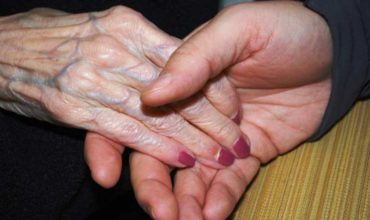–Besides their loved one’s health and physical decline, losing the ability to communicate frightens all caregivers the most, according to new survey announced by the National Family Caregivers Association—
KENSINGTON, Md., Oct. 25, 2011 /PRNewswire/ — A new survey released by the National Family Caregivers Association (NFCA) and Forest Laboratories, Inc. reveals what family caregivers fear most: first, their loved one’s general health and physical decline, and second, the fear that Alzheimer’s will take away their loved one’s ability to communicate. Communication decline with their loved ones is not just a fear but a major source of stress, and also interferes with their ability to fulfill responsibilities/obligations as a caregiver.
“Caregiving is incredibly stressful, and also very lonely and isolating, particularly with Alzheimer’s disease when the loved one gradually loses the ability to communicate effectively,” said Suzanne Mintz, president and chief executive officer of NFCA. “Caregivers have to improvise and find new ways to connect with their loved ones – whether it’s on an emotional level or about more practical matters.”
Conversations about emotions, medical decisions, insomnia/sleep disturbances, personal hygiene and medications are the most difficult, with over half saying they are “not very” or “not at all” able to communicate effectively on these issues. As a result, the majority of caregivers say they are decreasing their attempts at two-way communication with their loved ones.
Despite the stress associated with communicating, most caregivers surveyed adopted new ways to communicate with the person they care for (71 percent) and feel they have become better communicators themselves (76 percent). The most common alternative methods include observing facial expressions (84 percent) and body language (79 percent) and using pictures/photos (66 percent).
“Men and women responded similarly to the questions in the survey, with small differences,” said Mintz. “One difference was that nearly all females – 92 percent – caring for male patients rely on observing facial expressions to communicate. In contrast, 82 percent of males who care for female patients rely on observing facial expressions to communicate.”
It is estimated that 5.4 million Americans have Alzheimer’s disease and are being cared for by nearly 15 million unpaid caregivers — including family, friends, partners and neighbors. Often the equivalent of a full-time job, 80 percent of at-home care for people with Alzheimer’s or another dementia is provided by family caregivers.
“Family caregivers are the people who typically see this disease progress before their eyes. It becomes one of their many responsibilities to keep track of what’s going on with the patient on a daily basis and share the information with the doctor, which is why it’s important for the family caregiver and physician to have a regular dialogue and a good relationship,” said Gustavo Alva MD, DFAPA, Medical Director of ATP Clinical Research in Costa Mesa, CA. “Caregivers should regularly communicate what symptoms the patient is experiencing, because there are FDA-approved treatments available for all stages of the disease, which can make a real difference for patients and family caregivers.”
NFCA has created a new tip sheet specifically for Alzheimer’s family caregivers that offers advice on how they can communicate with their loved ones and others involved in the patient’s care; the tip sheet is available on www.thefamilycaregiver.org.
“The experiences of today’s family caregivers and the tools they are using to adapt are very important for all Americans to learn about,” said Mintz. “With Alzheimer’s disease on the rise, many people could be a caregiver starting tomorrow.”
Caring for someone with this disease seems to encourage caregivers to be proactive about their own risk for Alzheimer’s disease. Approximately 9 in 10 caregivers say that they will see a doctor immediately if they notice symptoms of Alzheimer’s disease in themselves.
Hispanic and African-American Caregivers
African-American caregivers reported spending more time caring for their loved one with Alzheimer’s disease, compared to Caucasian caregivers. The use of alternative communication methods is widely adopted by all groups, but Hispanic and African-American caregivers are more likely to report using such methods (81 percent of African Americans and 80 percent of Hispanics compared to 69 percent of Caucasians).
Additional survey findings reveal:
- Caregivers Have Help: Only a minority of caregivers (12 percent) said they are the only ones involved in caring for a loved one.
- Caregivers Worry about Themselves Too: Approximately three-fourths of Alzheimer’s disease caregivers worry about developing the disease.
- Younger Generation Playing a Role: Although most caregivers were aged 50 or older, a small, but significant minority of caregivers (7 percent) were under age 30, part of the “Millennial” generation. Most often, they are caring for grandparents (mean age of loved one=77).
The survey was conducted by GfK Roper Public Affairs & Corporate Communications on behalf of the National Family Caregivers Association and Forest Laboratories, Inc.
About Alzheimer’s Disease
Alzheimer’s disease is a progressive, neurodegenerative disorder characterized by problems with memory, thinking and behavior that eventually become severe enough to affect work, lifelong hobbies, and social life. Every 69 seconds, someone in the U.S. develops Alzheimer’s disease. As the baby boomer population continues to age, by 2050, someone will develop the disease every 33 seconds. The disease is the fifth leading cause of death for those aged 65 and older and the sixth leading cause of death across all ages in the U.S. Alzheimer’s-associated healthcare costs are also projected to increase from $183 billion in 2011 to $1.1 trillion by 2050.
About the Caregiver Survey
GfK Roper Public Affairs & Corporate Communications conducted the online study on behalf of the National Family Caregivers Association (NFCA) and Forest Laboratories, Inc. The survey was conducted among 674 Alzheimer’s disease (AD) caregivers between March 28 and April 25, 2011, including oversamples to reach 100 African-American and 100 Hispanic AD caregivers in the total sample. The results are weighted by age, race and education to reflect the population of Alzheimer’s disease caregivers.
Demographics of the Caregivers in the Survey
The majority of caregivers are full-time employees (49 percent); some are part-time employees (14 percent) or retired (24 percent). Sixty-nine percent of caregivers are married and 21 percent are parents or guardians of children under the age of 18. The average number of caregiving years is 4.1. Among the caregivers surveyed, 72 percent of patients cared for are female, and 28 percent male. The average age of the patient is 82 years, with 86 percent of patients aged 75 or older.
About the National Family Caregivers Association
For millions of Americans who care for loved ones with a chronic illness, disability, or the frailties of old age, NFCA addresses their common needs, regardless of their loved ones’ age or diagnoses in order to build their confidence and capabilities and help transform the quality of their lives. To learn more, visit www.thefamilycaregiver.org
About Forest Laboratories, Inc.
Forest Laboratories’ (NYSE: FRX) longstanding global partnerships and track record developing and marketing pharmaceutical products in the United States have yielded its well-established central nervous system and cardiovascular franchises and innovations in anti-infective and respiratory medicine. The Company’s pipeline, the most robust in its history, includes product candidates in all stages of development across a wide range of therapeutic areas. The Company is headquartered in New York, NY. To learn more, visit www.FRX.com.
SOURCE National Family Caregivers Association
http://www.thefamilycaregiver.org






